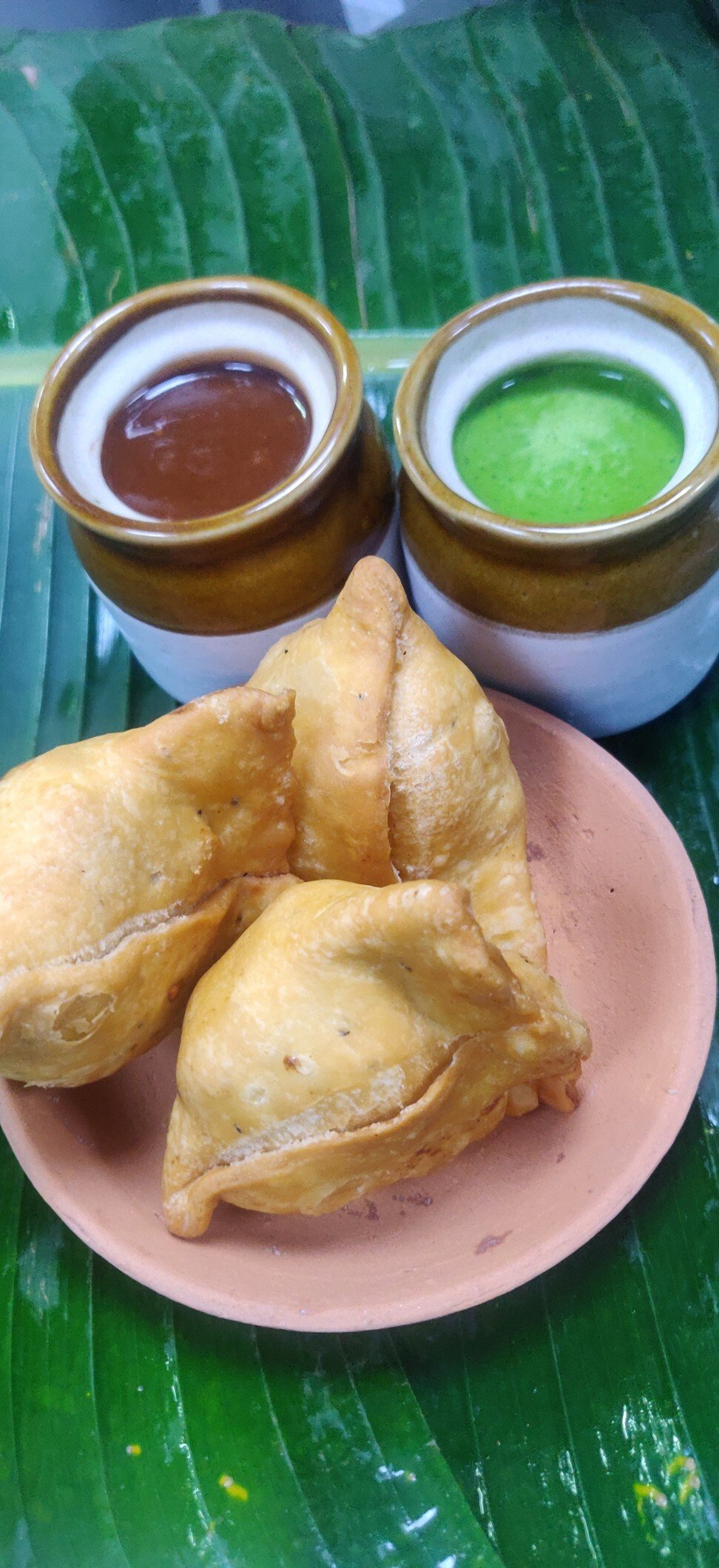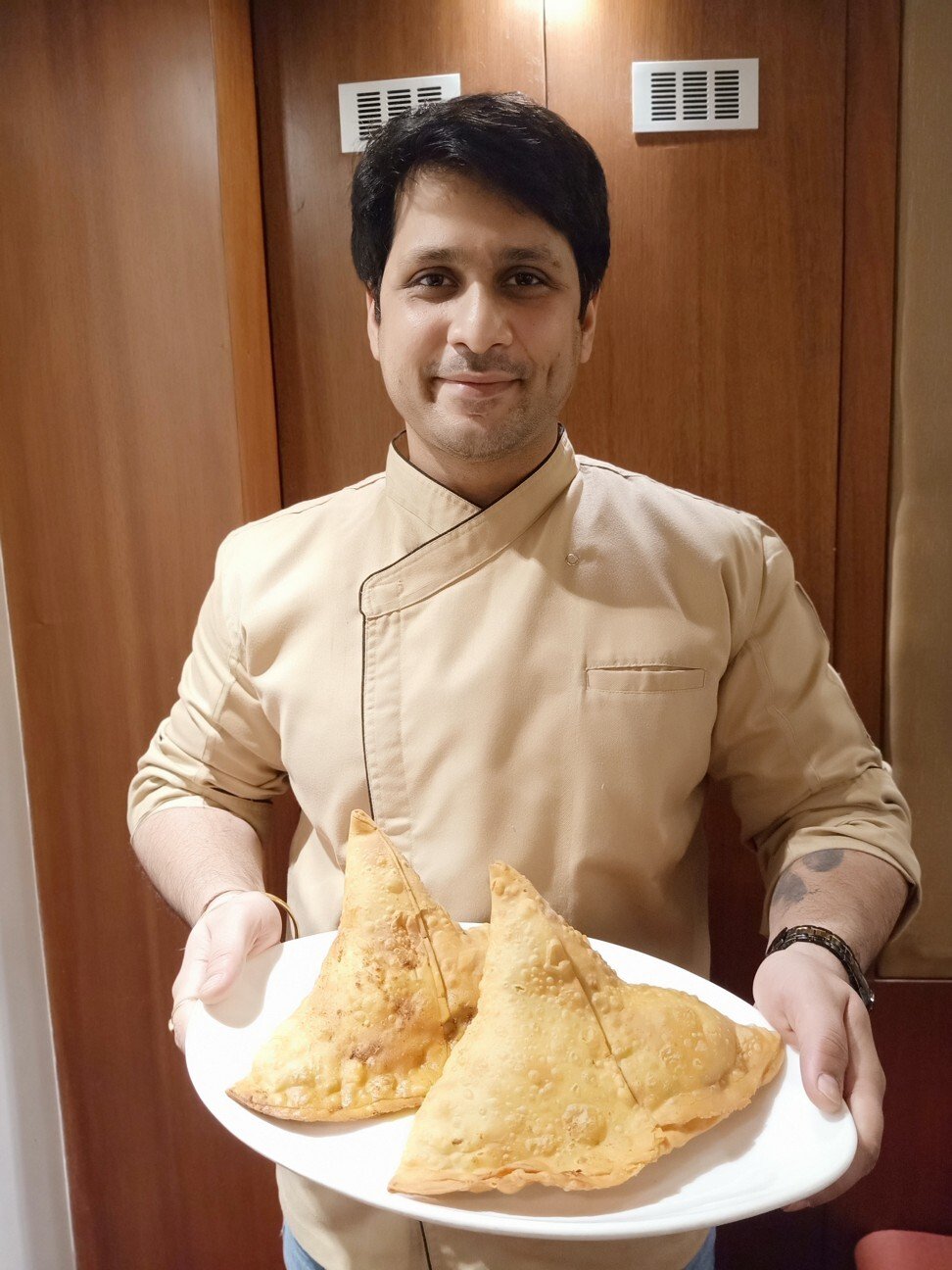
Egypt’s gift to India: the samosa, popular fried pastry snack named after the pyramids
- The snack travelled from Egypt to Libya to Central Asia before arriving in India via the Middle East
- The key to a good samosa lies in the pastry, says an Indian chef. He describes it as the perfect comfort food because it is tasty, cheap and versatile
Fans of the samosa in India call the triangular filled pastry the “king of snacks”, and Samosa Day is celebrated with much fervour across the South Asian country each year on September 5. Roadside stands selling the fried snack are ubiquitous across India.
The pastry shell is prepared with wheat flour, stuffed with spicy mashed potatoes, onions, green peas, a pinch of asafoetida and other spices and its edges sealed. It is fried until golden, drained and placed on a newspaper sheet to absorb the excess oil, then served with mint sauce or tamarind chutney.
Despite India’s craze for the samosa, it surprises many to know that its provenance isn’t Indian. The snack travelled from Egypt to Libya to Central Asia before arriving in the subcontinent via the Middle East.
Some food historians claim it was brought to India by chefs during the Delhi Sultanate period in the 13th century. The Delhi Sultanate was an Islamic empire that stretched over the Indian subcontinent for more than 300 years.
A refugee invented butter chicken, and changed the face of Indian cuisine
“Originally named samsa, after the pyramids in Central Asia, historical accounts also refer to the delicacy as sanbusak, sanbusaq or even sanbusaj, all deriving from the Persian word sanbosag,” says food historian Ajay Shukla.
In the Middle East, says Shukla, the semicircular version of the samosa is stuffed with cheese, onions, herbs, spices and minced meat. “In Israel, samosas have a chickpeas and pine nuts filling, while Portugal and Brazil are famous for their meaty chamuças and pasteis. Across Uzbekistan and Kazakhstan, you’ll find Uygur-style samosas with a heavier bread dough and a lamb centre,” he explains.
The true hallmark of a delicious samosa is its pastry. It should be crispy, not too thick nor too thin and a burnished brown in colour
The samosa also finds mention in literature. Persian scholar Abul-Fazl Bayhaqi refers to samosas in his records in 11th century as a “dainty delicacy, served as a snack in the great courts of the mighty Ghaznavid empire. The fine pastry was filled with minced meats, nuts and dried fruit and then fried till the pastry was crisp”.
Samosas quickly became a prized dish among Indian royalty. Moroccan traveller Ibn Battuta mentions their presence at Mughal emperor Muhammad bin Tughlaq’s banquets in 14th century Delhi. “They were made of minced meat cooked with almonds, pistachios, onions and spices placed inside a thin envelope of wheat and deep-fried in ghee,” he noted.
The snack’s inclusion in the Ain-I-Akbari, a 16th century document written by Mughal emperor Akbar’s court historian, Abul-Fazl, gave the dish a royal imprimatur. Fazl declared that among dishes cooked with wheat, there is the qutab, “which the people of Hind called the sanbusa”. Upon their arrival in India in the 17th century, the British became so enamoured with the samosa that they took it to all corners of their colonial empire.

“The true hallmark of a delicious samosa is its pastry,” explains Ritesh Negi, executive chef of the Radisson Blu MBD Hotel Noida in the northern Indian state of Uttar Pradesh. “It should be crispy, not too thick nor too thin and a burnished brown in colour.
“The oil’s temperature should be between 160-180 degrees Celsius [320-360 degrees Fahrenheit], though this also depends on the samosa’s size and how many are being fried in one go in the wok,” he says.

Samosas come in more varieties than than the vegetarian, chicken and lamb options typically found at Indian restaurants outside India. Various places in the country have come up with their own samosa variants – and there can be fierce debate over which one is the best.
In the southern city of Hyderabad, for instance, a samosa is called lukmi. Flat and square, and stuffed with kheema (minced mutton), it is a favourite delicacy during the holy month of Ramadan. In northern Punjab, a samosa is stuffed with potatoes, cinnamon, peppercorns, cloves, green cardamom, cumin, and fennel, coriander and dried pomegranate seeds.
Why cinnamon is good for you and could help prevent diabetes
Then there are samosas filled with noodles, cheese, pasta, lentils, chickpeas, chocolate, mushrooms, fish, chicken and corn. Their size also varies – from a monstrous six-incher (15cm long) to the bite-sized “nano” samosa served as a canapé at weddings and parties.
Samosa’s accompaniments are equally diverse, ranging from the classic choley (chickpeas) sabzi (an Indian term for a vegetable dish) to methi ki launji, or fenugreek seeds pickle. Some cooks pair it with a tomato and potato curry garnished with freshly chopped coriander leaves.
“We take pride in serving the country’s largest samosa,” says master chef Rahul Sood of The Embassy restaurant in New Delhi. In business since 1948, it serves a samosa three times the size of the standard ones. It is, as Sood puts it, “not a snack but a whole meal”. The restaurant also serves samosa burgers, as well as deconstructed samosas with a cottage cheese filling.

Such has been the dish’s popularity that three years ago, the restaurant launched a tuck shop just outside its doors just to sell samosas, where long queues can form. “We’ve come from Meerut [a city 150km or 93 miles from Delhi] to enjoy the samosas here,” says Rohit Agarwal, 36, a businessman and a regular. “They are simply irresistible.”
Modern takes on the snack are also in vogue. In 2016, husband and wife team of Shikhar Veer Singh and Nidhi Singh quit their jobs and sold their flat in the southern city of Bangalore to launch WoknStove Foodworks, a start-up that sells samosas under the brand name Samosa Singh.
The chain, which operates in southern Bangalore and Hyderabad, sells more than 50 types of samosas as well as a samosa chaat and various combos. In a nod to China, they make “samosa Szechwan” and “Chinese Samosa”, filled with fiery noodles and meats.
The delights of dosa, a savoury pancake that’s made for breakfast
The company raised US$2.7 million in funding last year, scaling up operations and expanding into new cities even as the pandemic ravaged food businesses. This year, it plans to cater to individual households through its cloud kitchen model.
Not all samosa innovations are a hit. Last year, when then US president Donald Trump visited India, the broccoli and corn ones served to him at a state banquet got unsavoury reviews. One Twitter user reacting to the dish wrote, “Broccoli samosas?”, with a puking emoticon.

Samosas in space
Usually, when chefs mention taking a dish to the “next level”, the reference is to elevating its taste. However, restaurateur Niraj Gadher took things quite literally by attempting to send the savoury, triangle-shaped Indian samosa into space.
To record the deep-fried pastries’ journey, the packet was fitted with a GoPro camera and a GPS tracker. However, a technical glitch caused it to crash-land in northern France the next day. Gadher messaged people in the area over Instagram to see if anyone could hunt down the snacks.
A follower discovered the remains of the balloon in a field in Picardy. Unfortunately, the samosas were missing from the crash site, leading Gadher to joke they “may have been consumed by French wildlife”.
The mystery of the missing samosas is still unresolved, but Gadher and his restaurant have tasted instant fame. They trended on social media and “the feedback is that it has triggered a lot of laughs and that’s what we wanted really, to spread joy”, says the chef.

